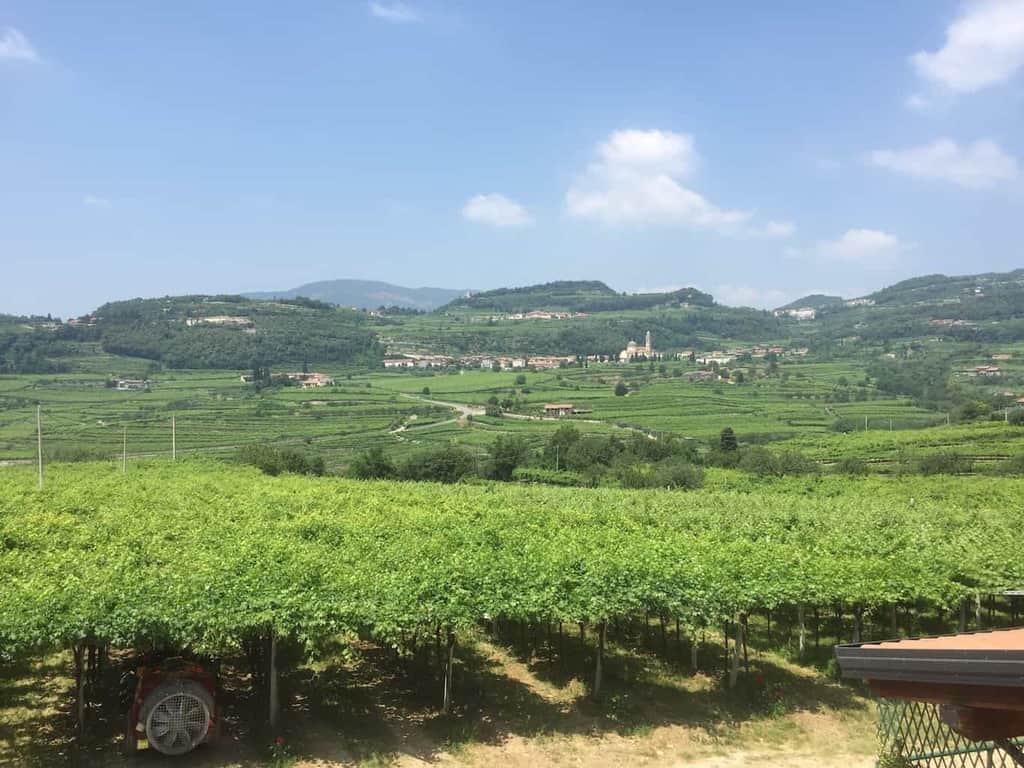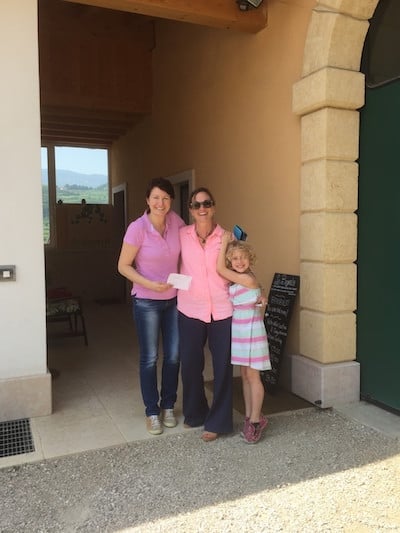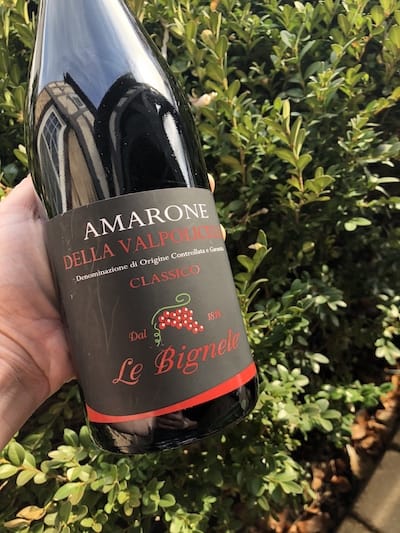With more than 1.9 million acres of vineyards, tens of thousands of wineries and hundreds of grape varieties, where can the Winetraveler even begin in Italy? Short of dropping everything and going all Under the Tuscan Sun – and even then, I’m not sure anyone can fully comprehend the depth of Italy’s viticulture, wines and beauty – it can be a daunting trip to plan.
After spending a summer exploring as many wine regions, and wineries, as possible in Northern Italy, I barely scraped the surface. What I can tell you is that those images you see gracing wall calendars, in movies, on The Wine Show and on postcards (does anyone send postcards anymore?) are as real and as captivating as you imagined. Perhaps better. I will never forget speeding down the Italian highway (thankfully I was not driving), mouth gaping open, eyes wide, watching the bright green rolling hills, vineyards, blue skies and mountains passing by, and thinking I get to live in f$#*ing Italy for the summer! Apologize for the profanity, but there really was no other way to voice my disbelief and excitement that a place like this existed. And I can tell you, that feeling never ended. To this day, my soul aches for my dolce vita.
Veneto
RELATED: Learn All About the Veneto Wine Region
Fortunately for me, I get to return to Italy today – in my mind at least – as we share with you a lovely winery in the Northern Italian wine region of Veneto, Le Bignele. Veneto is the leading wine producing region in Northern Italy, bordered by the foothills of the Alps to the north, Lombardy to the west and its capital city, Venice and the Adriatic Sea to the east. It’s a cooler climate growing region best known for Prosecco, Soave, Valpolicella and Amarone with 28 DOCs and 14 DOCGs. The fertile land and wines of Veneto gained notoriety in the 1960s and 1970s in the U.S. when Italian wine was trending (wicker basket Chianti ring a bell?), but it was more about mass quantity than quality wine at the time. While you will still come across mass produced, low quality wines in Veneto, you can also now find some truly fantastic options as well.
RELATED: Plan Your Trip to Veneto with our Partner Authentica Journeys
Some of the best wines in Veneto are found in the foothills of the Alps, where the well-drained, volcanic soils with a mixture of sand, clay and gravel lend to the vibrancy of the wines. And nestled amongst these hilltop vines, overlooking green valleys and rolling hills with the Adige river to the west is where you’ll find the family-owned, boutique winery, Le Bignele. I chose Le Bignele as my first stop for two reasons: I wanted an intimate introduction to the region and I was very curious about Amarone. I was not disappointed in either regard.
Arriving to the tasting appointment, with family in tow, I was greeted by Silvia, one of the daughters of the winery’s owners, two brothers, Luigi and Angelo Aldrighetti. Silvia gave a highly informative introduction to the vineyards, pointing out their eight-hectares of vines draping the surrounding hills, walked us through the production facility and cellar, and took us through the wooden racks on which the grapes are dried in a process called appassimento for the winery’s Amarone and Ricioto Classico.
Appassimento is the process by which grapes are either laid out on mats or lofted to concentrate the sugars prior to fermentation. At Le Bignele the grapes are laid across wooden mats and placed in the family’s orchards where they will concentrate for up to 120 days. During the process the grapes lose about one-third of their weight, developing intense flavors and sugars capable of producing full-bodied and powerful wines both dry and sweet, and not traditionally typical of cooler climate growth regions. Seeing the behind-the-scenes process always lends to a greater appreciation of what’s in the glass and at this point, I was very much looking forward to trying this illustrious Amarone.
Ties That Bind
After an in-depth walk-through of the property, Silvia invited us to the tasting room where a large wooden table was adorned with glasses, cheese and informational materials. Although this could have been mistaken for a formal affair, Silvia’s warm and familial personality made us feel as though we were sitting around a table with our own family. And it was a family affair indeed. In addition to my family, Silvia introduced us to her cousin Nicola who joined us for the tasting, as did another family from the states that happened upon the winery as they were driving through the region. As more places were set and new guests welcomed, Silvia shared the winery’s history dating back to 1818 when it was purchased by the Aldrighetti family.
The lots purchased were in the Valpolicella hills and known as “Bignele,” near the small country village of Valgatara, which today is an outlying suburb hamlet of Marano di Valpolicella. Since the early 1800s the family has farmed the land and today produces small quantities of high-quality Valpolicella Classico Superiore, Amarone and Recioto Classico. Brother Angelo is the vineyard manager, where he personally “supervises” each vine. Luigi, on the other hand, is in the cellar, managing the appassimento, barreling and overall wine production. Nicola is responsible for the bottling and labeling, while Silvia oversees all hospitality and commercial aspects of the winery. As for harvest, it’s all hands-on deck with the entire family hand-selecting bunches for the appassimento. The Aldrighetti family is involved at every stage of the winemaking process, and their passion, care and expertise are showcased in each wine.
Le Bignele Wines
Le Bignele only produces red wines from an easy-drinking table wine to the exquisite, meant-to-be-savored Recioto Classico. A tasting here is a fascinating expression through the fresh and fruity wines and the more robust, complex wines of Veneto. The grapes grown and used at Le Bignele are those common to many Valpolicellas and Amarones: Corvina, Corvinone, Rondinella and Molinara. Our tasting, which by the way lasted several hours over great conversation and much laughter, included each of Le Bignele’s wines:
- Doséto del Nonno – Rosso Verona IGT – a bright, easy-drinking red table wine representative of the classic fresh Valpolicellas of Veneto. 13.5% ABV
- Valpolicella Classico Superiore DOC – aged one-year in oak as is custom for a Classico Superiore, this wine presented with rich cherry and licorice flavors. 12.5% ABV
- Valpolicella Classico Superiore Ripasso DOC – aged between one and two years (depending on the vintage) after “resting” in oak casks for several weeks with the pomace of fermented Amarone, which adds more color, tannin, flavor and structure. A powerful, silky wine, the Ripasso is a big, fruit-forward wine with a long, complex finish. 13.5%-14% ABV
- Amarone Classico della Valpolicella DOC – this is the big dog, aged three years in oak after the grapes are hand-selected, taken through the appassimento process, crushed and pressed. It’s a powerful, dry red with a full-body, fragrant aromas, intense mocha and earthy flavors with a velvet consistency. 15% ABV (And this is where I personally have to disagree with The Wine Show’s Joe Fattorini, Amarone is by far sexier and more romantic than Soave! Still love ya Joe!)
- Recioto Classico della Valpolicella DOC – this sweet, rich wine aged for three years in oak is also made with the dried grapes; however, the fermentation is stopped before all the sugar is converted to alcohol. The result is a complex, sweet wine with rich flavors traditionally served after a meal. Only made in small quantities, this wine is a treat to taste if you come across it.
As a Winetraveler one of my favorite things about an experience is understanding the history, the stories and the culture behind the wine, and the tasting at Le Bignele checked all my boxes. It’s always much more interesting to experience a wine after learning the vineyard history and sharing glasses with the very people passionate about making it. We hope this small glimpse into the expansive region of Veneto will entice you to do the same.
(Winetraveler tip: And if you happen to make it to Le Bignele, do stop at the Antica Osteria Paverno for an authentic, homemade lunch showcasing the bounty of the Valpolicella region. You won’t regret it!)


